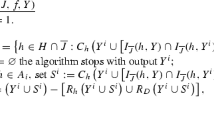Abstract
In this paper, we analyze capacity manipulation games in hospital-intern markets inspired by the real-life entry-level labor markets for young physicians who seek residencies at hospitals. In a hospital-intern market, the matching is determined by a centralized clearinghouse using the preferences revealed by interns and hospitals and the number of vacant positions revealed by hospitals. We consider a model in which preferences of hospitals and interns are common knowledge. Hospitals play a capacity-reporting game. We analyze the equilibria of the game-form under the two most widely used matching rules: hospital-optimal and intern-optimal stable rules. We show that (i) there may not be a pure strategy equilibrium in general; and (ii) when a pure strategy equilibrium exists, every hospital weakly prefers this equilibrium outcome to the outcome of any larger capacity profile. Finally, we present conditions on preferences to guarantee the existence of pure strategy equilibria.
Similar content being viewed by others
References
Abdulkadiroğlu A, Sönmez T (1998) Random serial dictatorship and the core from random endowments in house allocation problems. Econometrica 66:689–701
Abdulkadiroğlu A, Sönmez T (2003) School choice: a mechanism design approach. Am Econ Rev 93:729–747
Alcalde J (1995) Exchange-proofness or divorce-proofness? Stability in one-sided matching markets. Econ Des 1:275–287
Alcalde J (1996) Implementation of stable solutions to the marriage problem. J Econ Theory 69:240–254
Alcalde J, Barberà S (1994) Top dominance and the possibility of the strategy-proof stable solutions to matching problems. Econ Theory 4:417–435
Alcalde J, Romero-Medina A (2000) Simple mechanisms to implement the core of college admissions problem. Games Econ Behav 31:294–302
Balinski M, Sönmez T (1999) A tale of two mechanisms: student placement. J Econ Theory 84:73–94
Banerjee S, Konishi H, Sönmez T (2001) Core in a simple coalition formation game. Soc Choice Welf 18:135–153
Dubins LE, Freedman DA (1981) Machiavelli and the Gale-Shapley algorithm. Am Math Mon 88:485–494
Gale D, Shapley LS (1962) College admissions and the stability of marriage. Am Math Mon 69:9–15
Gale D, Sotomayor M (1985a) Some remarks on the stable marriage problem. Discrete Appl Math 11:223–232
Gale D, Sotomayor M (1985b) Ms. Machiavelli and the stable matching problem. Am Math Mon 92:261–268
Irving RW (1998) Matching medical students to pairs of hospitals: a new variation on a well-known theme. In:Proceedings of ESA ’98, 6th annual European symposium on algorithms, Springer, Berlin Heidelberg New York, pp. 381–392
Kara T, Sönmez T (1996) Nash implementation of matching-rules. J Econ Theory 68:425–439
Kara T, Sönmez T (1997) Implementation of college admission rules. Econ Theory 9:197–218
Ma J (1995) Stable matchings and rematching-proof equilibria in a two-sided matching market. J Econ Theory 66:352–369
Ma J (1997) Manipulation and stability in a college admissions problem. Rutgers University working paper
Milgrom P, Shannon C (1994) Monotone comparative statics. Econometrica 62:157–180
Papai S (2000) Strategyproof assignment by hierarchical exchange. Econometrica 68:1403–1433
Postlewaite A (1979) Manipulation via endowments. Rev Econ Stud 46:255–262
Roth AE (1982) The economics of matching: stability and incentives. Math Oper Res 7:617–628
Roth AE (1984) The evolution of the labor market for medical interns and residents: a case study in game theory. J Polit Econ 92:991–1016
Roth AE (1985) The college admissions problem is not equivalent to the marriage problem. J Econ Theory 36:277–288
Roth AE (1991) A natural experiment in the organization of entry level labor markets: regional markets for new physicians and surgeons in the UK. Am Econ Rev 81:415–440
Roth AE, Peranson E (1999) The redesign of the matching market for American physicians: some engineering aspects of economic design. Am Econ Rev 89:748–780
Roth AE, Rothblum U (1999) Truncation strategies in matching markets - in search of advice for participants. Econometrica 67:21–44
Roth AE, Sotomayor M (1989) The college admissions problem revisited. Econometrica 57:559–570
Roth AE, Sotomayor M (1990) Two-sided matching: a study in game theoretic modeling and analysis. Cambridge University Press, Cambridge
Roth AE, Vande Vate JH (1990) Random paths to stability in two-sided matching. Econometrica 58:1475–1480
Roth AE, Xing X (1994) Jumping the gun: imperfections and institutions related to the timing of market transactions. Am Econ Rev 84:992–1044
Sertel MR (1994) Manipulating Lindahl equilibrium via endowments. Econ Lett 46:167–171
Shin S, Suh SC (1996) A mechanism implementing the stable rule in marriage problems. Econ Lett 51:185–189
Sönmez T (1996) Strategy-proofness in many-to-one matching problems. Econ Design 1:365–380
Sönmez T (1997a) Games of manipulation in marriage problems. Games Econ Behav 20:169–176
Sönmez T (1997b) Manipulation via capacities in two-sided matching markets. J Econ Theory 77:197–204
Sönmez T (1999) Can pre-arranged matches be avoided in two-sided matching markets. J Econ Theory 86:148–156
Svensson LG (1994) Queue Allocation of Indivisible Goods. Soc Choice Welfare 11:323–330
Thomson W (1987a) Monotonic allocation mechanisms. University of Rochester working paper
Thomson W (1987b) Monotonic allocation mechanisms in economies with public goods. University of Rochester working paper
Thomson W (1995) Endowment monotonicity in economies with single-peaked preferences. University of Rochester working paper
Author information
Authors and Affiliations
Corresponding author
Rights and permissions
About this article
Cite this article
Konishi, H., Ünver, M.U. Games of Capacity Manipulation in Hospital-intern Markets. Soc Choice Welfare 27, 3–24 (2006). https://doi.org/10.1007/s00355-006-0097-z
Received:
Accepted:
Published:
Issue Date:
DOI: https://doi.org/10.1007/s00355-006-0097-z




